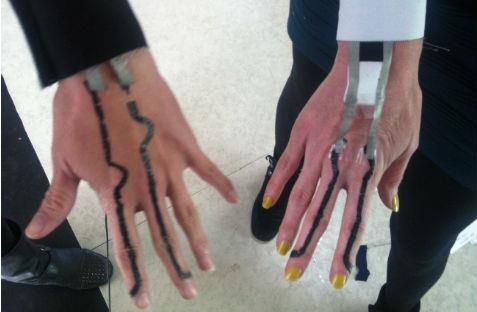Diane von Furstenberg’s runway show for Spring 2013 featured models wearing Google Glass. But the eye-wear that’s set to be the next technology boom is only the beginning for Smart Fashion – a new genre that interprets ‘smart’ along the lines of your phone not your formal wardrobe.
ETextiles, wearable technology and interactive clothing are the new buzzwords among designers for whom circuitry and sensors are the new fabric and thread.
Smart Fashion has already been successfully integrated into various commercial markets. Manufacturers including SmartLife and Textronics have created eTextiles that give the wearer information on their vital signs and body movement. This has proven popular in sport, healthcare and military arenas. It is now possible for fabric to measure your heart rate, respiration rate, temperature, and perspiration level – so we are hoping for a sweatshirt that is guaranteed against the dreaded armpit sweat stain.
But at the aesthetic and conceptual end of the fashion market, artists and developers are pushing the possibilities much further, using soft circuitry and other wearable technologies as a platform for audio, video, visual and connective projects.
Tara Pattenden, a new media artist and musician, combines technology and textiles to create costumes that are instruments with interfaces controlled by touch and movement.
‘Most recently I have worked on Maelstrom 2600, which is a Modular Lunetta synthesizer consisting of five monsterish costumes. Each costume is its own sound module and the sound can be manipulated by people plugging tentacles together like a patch lead on a synth.’
Camille Baker, a media artist, curator and researcher, and Kate Sicchio, a choreographer, media artist and performer, explored the concept of ‘body hacking’ in their recent workshops at the International Symposium of Electronic Art (ISEA). Body hacking deals with the imaginative re-purposing of electrical equipment and computers to explore biological data.
‘We’re looking at using various kinds of body sensors to extract, if you will, the code or data from the body and are finding new ways to repurpose it in the way that you would repurpose program code.’
This could translate into various external effects, such as flashing lights or video, triggered by signals from the body. It could even extend into the use of medical sensors such as ultra-sound or glucose sugar sampling for artistic projects in the future.
Beyond clothing, digital cosmetics can turn your body into a display screen Thea Baumann has developed the Metaverse nails ‘appcessory’, showcased at the ISEA as part of the Metaverse Makeover event. Metaverse nails are fashion stick-on nails that interact with a social mobile interactive game application to show holographic pictures and patterns
Baumann is also researching and developing I<3IDORU, a project to create augmented-reality (AR) glasses. Users will be able to slip on the glasses and experience ‘dates’ with virtual pop stars.
‘I’m interested in forging a new path in digital cosmetics and wearable fashion appcessories; using the internet and the medium of mixed reality for a means and layer for self-expression and transformation: qualities which form the driving raison d’etre for the cosmetics and fashion industries.’
While some smart fashion is about artistic exploration – like Sicchio’s dance and video work – or party tricks – a headpiece called Blinklifier that lights up when you blink – there are also more practical products headed for the consumer market. ‘There are shoes with GPS to find your way home and items that change colour with the weather or sense your mobile phone or link to social networking,’ says Pattenden. Other notable creations include scarves that change colour to match your outfit, gloves that let you touch electronic interfaces and eTextiles that alert you when you have a message.
Baker predicts eTextiles will soon be no more high-tech than answering your smart phone. ‘The thing that’s really cool about it now versus when I was playing with it maybe ten years ago is that there’s a much bigger community doing this, there’s so much more development and it’s so much less intimidating than it was. It seemed like this really hardcore engineering thing, you know, way back when but now it seems like a fun thing you do on a Saturday afternoon with people.’
Baker and Sicchio rely on DIY electronics they say are becoming much cheaper and easier to use. Popular devices include the Arduino microcontroller, which can control programs and physical outputs such as lights and motors, and sensors like Adafruit, which can detect force, temperature, orientation, light and more depending on what kind you have. There is also a growing variety of conductive thread well suited to crafting that can carry electrical current.
For those who are interested in using these technologies there are a number of ways to learn. eTextile workshops run regularly around Australia in venues such as the Edge in Brisbane and at ACMI in Melbourne and there is an abundance of online resources, notably http://www.kobakant.at/DIY/ and www.lbruning.com/.
So will the future look like a scene from Tron? Not according to Baker and Sicchio, who say we can expect hidden circuitry that is comfortable and attractive. Instead of carrying around an external device, our clothes and even our bodies will become an interface.
‘We’re going to be digital beings and digital cyborgs without even putting a lot of thought into it…. people won’t even notice that they’re wearing these electronics, it’ll all be ubiquitous in everything.’
But there’s a way to go. The current prototype of Google Glass still requires the wearer to don a device developed for technological rather than aesthetic impact. Says Baumann: ‘Although I think the future challenge of wearable technology is actually making wearable technology fashionable and designed for the tastes and sensibilities of young female consumers. Google Glass – just isn’t hot right now.’





